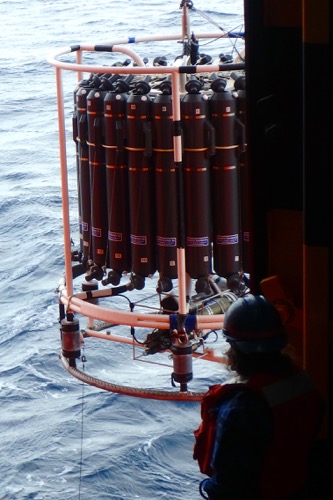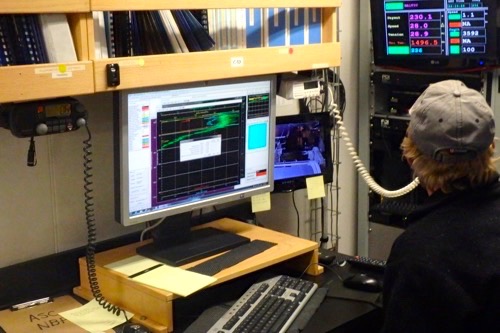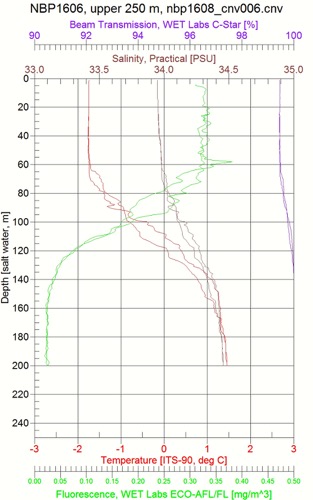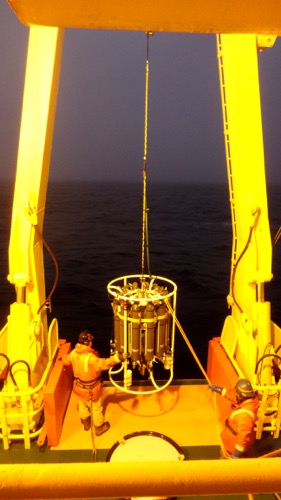Science Update
Today was a long day! Yesterday's powerful winds made it difficult to sample, so we delayed the start of Incubation 2 until today. Incubation sampling requires three full casts of the trace metal rosette, followed by time to fill bottles and transfer everything to the incubation van. To learn more about the incubation experiment set-up, read this Incubation SamplingSampling refers to the process of selecting units or portions of a larger group that will be studied in order to answer questions about the larger group. The units can be people, water samples, ice cores, or any other appropriate object. Participants will explore the meaning of sampling and how it impacts experimental design and explore factors that define and limit sampling in the variety of projects visited during the expedition. They will consider how results from the chosen samples are used to describe the bigger target of a project's study. Day 1 journal from September 14th.
Layers
The ocean can respond to many changes including the gain and loss of heat, the freezing and thawing of ice, and the movement of water due to winds. These changes can affect different characteristics of the water and help to create a layered system. Two factors that oceanographers study to learn more about the water are temperature and salinity (or the concentration of dissolved salts in the water). Measurements of the temperature and salinity of the water can be used to calculate the density of the water. If temperature decreases or salinity increases, the density of the water increases. If the density of the water is different at various depths, layers are created in the water column. These layers can cause circulation of the water, called thermohaline circulationThermohaline circulation is ocean water movement driven by differences in density caused by changes in temperature and salinity. One way to remember this term is: thermo= temperature and haline=salt.. This circulation can help to mix nutrients into the surface ocean and create areas of productivity in the ocean.
Conductivity, Temperature and Depth (CTDA research tool that is submerged in the water to measure conductivity (salinity), temperature, and depth.)
Oceanographers have developed CTDs to determine the vertical profiles of temperature and salinity. Early sampling methods including individual bottles attached to line at certain length intervals. The bottles were lowered into the water column and a weight was used to trigger the bottles to close. This allowed for only one water sample to be collected at each depth. In the 1980s, Neil Brown of the Woods Hole Oceanographic Institution (WHOI) developed technology referred to as a CTDA research tool that is submerged in the water to measure conductivity (salinity), temperature, and depth.. The CTDA research tool that is submerged in the water to measure conductivity (salinity), temperature, and depth. is used to continuously determine the temperature, salinity and depth as the machine moves through the water column. The CTDA research tool that is submerged in the water to measure conductivity (salinity), temperature, and depth. can be deployed on its own, but is often mounted on a rosette that also holds water sampling bottles. In the image below, the CTDA research tool that is submerged in the water to measure conductivity (salinity), temperature, and depth. sensors are housed in the greenish color tube at the bottom of the rosette.

Data from the CTDA research tool that is submerged in the water to measure conductivity (salinity), temperature, and depth. travels over a conducting wire cable to a computer aboard the research ship. Data is projected onto a computer monitor for scientists to view in real-time. Decisions regarding where to collect water samples can be made by looking for mixed layers or other significant changes in the water column. A mixed layer is a region where wind mixes the top layers of the ocean. This layer is distinct from the deep ocean. Each bottle can collect a water sample using a click of the computer mouse. If the rosette holds 24 bottles, then 24 different samples can be collected. Or, scientists may choose to collect 3 samples at each depth, or some other combination.

More than 40 CTDA research tool that is submerged in the water to measure conductivity (salinity), temperature, and depth. deployments, or casts have been completed on this research cruise (so far). The image below shows data produced from one of these casts. The red line indicates the temperature of the water and the brown line indicates the salinity of the water. You will notice that the temperature and density change very little in the upper surface of the water column (above 60m). This area of uniformity is the mixed layer. With the high winds and rough seas that we have experienced in this area, the mixed layer can sometimes extend much farther into the water column as the waves churn up the ocean and cause mixing. This can create challenges for phytoplankton due to light limitation, but we will discuss that in another journal.

One interesting note to point out on the CTDA research tool that is submerged in the water to measure conductivity (salinity), temperature, and depth. data from the cruise has to do with the temperature. In most parts of the temperate oceans, temperature decreases with depth. If you have ever been swimming in a lake, you may have experienced the colder waters as you go deeper into the lake. The same is generally true in the ocean. You may notice, however, that the red line in the image moves towards the right as the depth increases. This means that the water temperature is actually increasing as you move deeper into the water column. Why? The surface temperature combined with cold freshwater from ice sources help to make the surface of the water colder than the deeper portions. This is not surprising to scientists that study the Southern Ocean, but it was surprising to me when I first starting watching some of the CTDA research tool that is submerged in the water to measure conductivity (salinity), temperature, and depth. casts.
Multi-purpose Equipment
CTDA research tool that is submerged in the water to measure conductivity (salinity), temperature, and depth. sensors can also be equipped with sensors for oxygen, nutrients, sound velocity, light transmission, and water transparency. The ability to add additional sensors to the CTDA research tool that is submerged in the water to measure conductivity (salinity), temperature, and depth. allows scientists to study various aspects of the water column with a single deployment of the CTDA research tool that is submerged in the water to measure conductivity (salinity), temperature, and depth.. The CTDA research tool that is submerged in the water to measure conductivity (salinity), temperature, and depth. rosette is deployed off the side of the research ship using cranes.



Comments